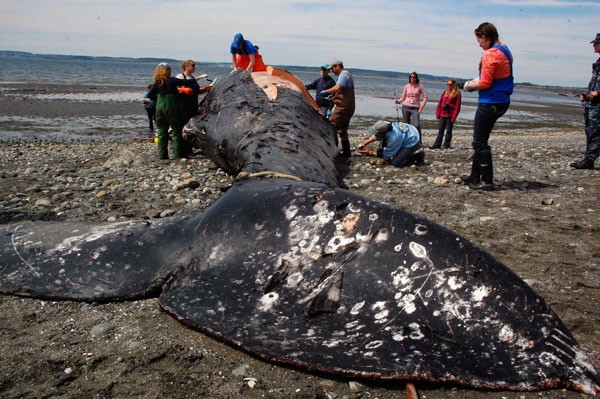A dead gray whale that was found floating in Saratoga Passage Sunday was necropsied on a beach on Whidbey Island Naval Air Station Monday.
According to Susan Berta, co-founder of the Orca Network, the whale was spotted by citizens in the early morning hours just north of Camano Island State Park. The whale remained in the same position for most of the day and was towed that evening to a beach off Polnell Point by Deception Pass Tours in Oak Harbor.
Several groups, including Cascadia Research, the state Department of Fish and Wildlife and the Central Puget Sound Marine Mammal Stranding Network spent much of Monday necropsying the whale.
At 37 feet in length, it has been identified as a male age 6 to 7 years and weighing in at about 30 tons. As of Tuesday, following the necropsy, the whale’s identity and where it hails from was still unknown.
Researchers were also unable to say how the animal died as there were no visible indications of trauma or health problems.
Matt Klope, a volunteer with the Marine Mammal Stranding Network and a biologist who does work for the Navy, said determining what killed the whale was one of the main goals of the necropsy.
“Basically, it’s to look for a cause of death,” Klope said.
Samples of the whale’s skin and blubber, organs and blood were collected. Researchers will test for signs of disease and try to determine the general health of the animal before it died.
The corpse can also yield important research data about the environment the whale lived in, as biological samples will show the presence of heavy metals or any other toxins in the ocean, said Jessie Huggins, stranding coordinator with Cascadia Research.
“It sheds light on the overall ecosystem’s health,” Huggins said.
While the whale’s early demise was unfortunate, the information its carcass will leave behind is extremely valuable, especially because it can provide research data that is otherwise very difficult to obtain.
“These kinds of questions can’t be answered with live whales,” Huggins said.
According to Klope, volunteers will spend the next few days cleaning the whale’s skeleton the best they can. The bones will then spend the next two months submersed at the Seaplane Base marina for sea creatures to finish the job.
“We’re not going to waste our time cleaning them when Mother Nature can do a much better job,” he said.
Once raised, the skeleton will spend a few weeks bleaching in the sun before being donated and shipped to the Smithsonian Institution’s Museum of Natural History in Washington, D.C.



